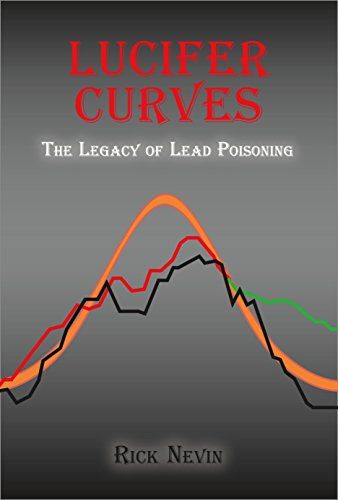Lucifer Curves tells the stranger-than-fiction true story of how preschool lead poisoning has caused crime waves across centuries and around the world. Lead poisoning also explains USA racial disparities in education, abortion and unwed birth rates, and arrest and incarceration rates.
Rick Nevin's peer-reviewed research on this subject has been widely reported by the global news media. In Lucifer Curves, Nevin puts all of the pieces together, including figures showing how lead exposure trends have accurately predicted ongoing crime trends in the USA, Canada, Britain, Australia, and New Zealand. Moreover, Lucifer Curves presents new pieces of this puzzle, showing how lead poisoning can explain the "dawn to dusk of delinquency" and historic trends in stature known as the "antebellum puzzle."
Other figures show that lead poisoning has also predicted USA trends in education and unwed teen pregnancy. Nevin presents clear evidence that lead poisoning has caused these societal trends, based on causation indicators that the World Health Organization has described as a “mainstay of epidemiological textbooks and data interpretation.”
Nevin presents this evidence in terms accessible to anyone with a curious mind. He also explains how preschool lead exposure still poses an important public health risk, how we can economically eliminate the greatest source of that risk, and how the legacy of lead poisoning has profound implications for current policy debates over criminal justice reform and the death penalty.

Order at BookBaby, Amazon, Barnes & Noble
Reviews
Goodreads: This book is blowing my mind. I am still thinking about its connections and implications. A lot of statistics that get explained in lay language (thank you) and explores the relationship between lead poisoning and trends of violence around the world.
Amazon: Read this book. It will change your perceptions on the conversation concerning what constitutes meaningful and appropriate policy, and provides a new context and consideration for historical analyses of health, crime, and intelligence in the United States, and the world around.
Amazon: Nevin ties together research from various countries and times and builds a strong argument that leads to contamination in water, soil, and air have had a devastating and costly effect on society. This research-based book explains the secular trends in violence. It explains how air pollution from lead in gasoline (banned since the 1980's) caused a rise in crime, especially violent crime, with a peak lagging 22 years after infants are exposed to lead. Lead remains in the paint of older homes and in the soil of polluted areas and continues to harm children, especially the poorest neighborhoods.
Anyone interested in the field of criminology or public health should be interested in this book. Criminology is a social science that has largely ignored the effects of health and pollution on crime, and thus tends to attribute crime to poverty, social stress, and education, and credit policing high rates of incarceration, and long prison terms with lowering the crime rate. Nevin lays out the data and clear arguments showing that those factors, while costly, The criminal justice system has had much less effect on lowering the rate of crime in America than has the Environmental Protection Agency and the rules it put into place to lower lead contamination.
Although lead levels have fallen greatly, the legacy of lead is still present in older homes and the soil of urban areas. Perhaps as important is that this lesson remains salient in a time of cutting EPA funding.
